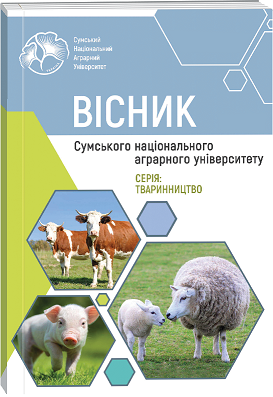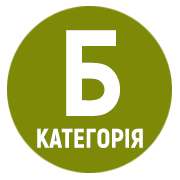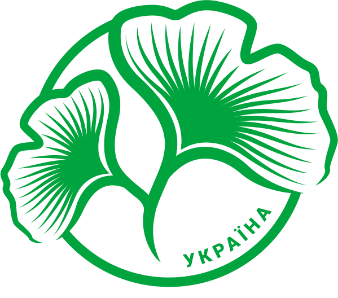THE CONTENT OF PB AND CD IN FEED AND THEIR TRANSITION INTO MILK AT DIFFERENT PRODUCTIVITY OF COWS
Abstract
As a result of hostilities in Ukraine, the accident at the Chernobyl nuclear power plant and other man-made disturbances, a growing threat to the health of animals and people has arisen. An important role in this process belongs to the anthropogenic entry into the biosphere of heavy metals, which are highly toxic, have the ability to accumulate in the body of animals and people, and cause harmful effects even in low concentrations. Monitoring of feed and milk contamination with heavy metals (Pb and Cd) was carried out in agricultural enterprises of Zhytomyr region with different levels of cow productivity: PAF "Yerchyki" with a daily milk yield of 20–22 kg of milk and DPDG "Nova Peremoga" with a daily milk yield of 13–14 kg of milk. The type of animal feeding in both farms is silage-hay-hay-concentrate. Preparation of selected samples of feed and cow milk for determination of heavy metals in their composition was carried out by the method of dry mineralization according to DSTU 7670:2014, analysis – on an atomic absorption spectrophotometer "Kvant-2A". The results of the conducted studies on the content of Pb and Cd in average samples of fodder crops clearly indicate the presence of significant fluctuations in heavy metals within farms and feeds. High concentrations of Pb and Cd were found in roughage and sunflower cake and meal – 1.238–3.639 mg/kg and 0.199–0.404 mg/kg and 1.904–2.464 mg/kg and 0.408–0.908 mg/kg, respectively. In addition, alfalfa hay and sunflower cake and meal exceeded the MPC for Cd content by 1.35–3.03 times. Feeds prepared at the Yerchiky Agricultural Farm compared to the Nova Peremoga Agricultural Farm contain significantly higher amounts of Pb and Cd: in alfalfa hay – 2.42 times and 1.68 times, in barley straw – 1.23 and 1.21, in corn silage – 1.61 and 2.23, in alfalfa haylage – 1.24 and 1.56, in sunflower meal and meal – 1.29 times and 2.22 times, respectively. According to the results of milk analysis, in both farms, the regulatory requirements for Pb content were exceeded by 1.02–1.86 times and Cd – by 1.30 times (Yerchiky Agricultural Farm). The highest rates of accumulation and transfer of heavy metals from ration feed to milk were observed in the farm with higher cow productivity.
References
2. Ali, H., Khan, E., & Ilahi, I. (2019). Environmental chemistry and ecotoxicology of hazardous heavy metals: Environmental persistence, toxicity, and bioaccumulation. Journal of Chemistry, vol. 2019, pp. 1–14. DOI: https://doi.org/10.1155/2019/6730305.
3. Bakhrillaeva, M., & Razamuradov Z. (2022). The Negative Effect of Heavy Metal Salts on the Body of Mammal Animals. Open Journal of Animal Sciences, vol. 12, no. 4, pp. 704–711. DOI: https://doi.org/10.4236/ojas.2022.124048.
4. Bartkowiak, A. (2021). Influence of Heavy Metals on Quality of Raw Materials, Animal Products, and Human and Animal Health Status. Environmental Impact and Remediation of Heavy Metals, pp. 1–7. Doi: https://doi.org/10.5772/ intechopen.102497.
5. Bigalke, M., Ulrich, A., Rehmus, A., & Keller, A. (2017). Accumulation of cadmium and uranium in arable soils in Switzerland. Environmental Pollution, no. 221, pp. 85–93. DOI: https://doi.org/10.1016/j.envpol.2016.11.035.
6. Brygadyrenko, V., & Ivanyshyn, V. (2015). Chandes in the body mass of Megaphyllum kievense (Diplopoda, Julidae) and the granulometric composition of leaf litter subject to different concentrations of copper. Journal of Forest Sciense, vol. 61(9), pp. 369–376. DOI: https://doi.org/10.17221/36/2015-JFS.
7. Dai, S.Y., Jones, B., Lee, K-M., Li, W., Post, L., & Herrman, T.J. (2016). Heavy metal contamination of animal feed in Texas. Journal of Regulatory Science, vol. 4, no. 1, pp. 21–32. DOI:https://doi.org/10.21423/JRS-V04N01P021.
8. DSTU ISO 6497:2005 (2005). Kormy dlya tvaryn. Metody vidbyrannya prob (ISO 6497:2002, IDT) [Fodder for animals. Sampling methods (ISO 6497:2002, IDT)]. Kyyiv: DP «UkrNDNTS». (in Ukrainian).
9. DSTU ISO 707:2002 (2003). Moloko i molochni produkty. Nastanova z vidbyrannya prob [Milk and dairy products. Guidelines for sampling]. Kyyiv: Derzhspozhyvstandart Ukrayiny. (Natsionalʹnyy standart Ukrayiny). (in Ukrainian).
10. DSTU 7670:2014 (2015). Syrovyna i produkty kharchovi. Hotuvannya prob. Mineralizatsiya dlya vyznachennya vmistu toksychnykh elementiv [Raw materials and food products. Preparation of samples. Mineralization to determine the content of toxic elements]. Kyyiv: Minekonomrozvytku. (in Ukrainian).
11. Han, J.L., Pan, X.D., & Chen, Q. (2022). Distribution and safety assessment of heavy metals in fresh meat from Zhejiang, China. Scientific Reports, no. 12:3241, pp. 1–8. DOI: https://doi.org/10.1038/s41598-022-07214-3.
12. Hashemi, S. (2018). Heavy metal concentrations in bovine tissues (muscle, liver and kidney) and their relationship with heavy metal contents in consumed feed. Ecotoxicokogy and Environmental Safety, vol. 154 (15), pp. 263–267. DOI: https://doi.org/10.1016/j.ecoenv.2018.02.058.
13. Hlihor, R.M., Rosca, M., Hagiu-Zaleschi, L., Simion, I.M., Daraban, G.M., & Stoleru, V. (2022). Medicinal Plant Growth in Heavy Metals Contaminated Soils: Responses to Metal Stress and Induced Risks to Human Health. Toxics, vol. 10, issue 9, pp. 499. DOI: https://doi.org/10.3390/toxics10090499.
14. Kushnir, S. O. and Onipko, A. D. (2018). Ekolohichna sytuatsiya v Ukrayini: analiz problem ta finansuvannya napryamkiv yikh podolannya [Environmental situation in Ukraine: analysis of problems and financing directions for overcoming them]. Ekonomichnyy prostir, no. 136, pp. 191–201. (in Ukrainian).
15. Lavryshyn, Y., Gutyj, B., Palyadichuk, O., & Vishchur, V. (2018). Morphological blood indices of bulls in experimental chronic cadmium toxicosis. Scientific Messenger of LNU of Veterinary Medicine and Biotechnologies. Series: Veterinary Sciences, no. 20 (88), pp. 108–114. DOI: https://doi.org/10.32718/nvlvet8820.
16. Lavryshyn, Y., & Gutyj, B. (2019). Protein synthesize function of bulls liver at experimental chronic cadmium toxicity. Scientific Messenger of LNU of Veterinary Medicine and Biotechnologies. Series: Veterinary Sciences, no. 21(94), pp. 92–96. DOI: https://doi.org/10.32718/nvlvet9417.
17. Mamenko, O.M. and Portyanyk, S.V. (2019). Vplyv typiv hodivli koriv na vmist vazhkykh metaliv u molotsi [The influence of types of cow feeding on the content of heavy metals in milk]. Naukovyy visnyk LNUVMB imeni S.Z. Hzhytsʹkoho. Seriya: Silʹsʹkohospodarsʹki nauky, vol. 21, no. 90, pp. 38–48. (in Ukrainian).
18. Mamenko, O.M. and Portyanyk, S.V. (2020). Produktyvnistʹ koriv za alimentarnoho nadkhodzhennya v orhanizm vazhkykh metaliv [Productivity of cows under dietary intake of heavy metals]. Tekhnolohiya vyrobnytstva i pererobky produktsiyi tvarynnytstva, no. 1, pp. 46–62. DOI: https://doi.org/10.33245/2310-9270-2020-157-1-46-62. (in Ukrainian).
19. Mamenko, O.M., & Portiannik, S.V. (2021). Features of heavy metal excretion in dairy cows in agroecosystems around an industrial city and the production of environmentally safe milk. Ukrainian Journal of Ecology, vol.1 1(5), pp. 29–43. DOI: https://doi.org/10.15421/2021_207.
20. Nakaz MOZ Ukrayiny vid 22.05.2020 r. №1238 Derzhavni sanitarni pravyla i normy «Maksymalʹno dopustymi rivni okremykh zabrudnyuyuchykh rechovyn u kharchovykh produktakh» [Order of the Ministry of Health of Ukraine dated May 22, 2020 No. 1238 State sanitary rules and regulations "Maximum permissible levels of certain pollutants in food products"].(in Ukrainian).
21. Naydʹonova, O.O. (2023). Ekolohichni problemy Ukrayiny: naslidky viyny [Elektronnyy resurs] : vebliohrafichnyy pokazhchyk [Ecological problems of Ukraine: consequences of the war [Electronic resource]: webliographic index]. Kropyvnytsʹkyy : TSNTU, 19. (in Ukrainian).
22. Notten, M.J., Oosthoek, A.J., Rozema, J., & Aerts, R. (2005). Heavy metal concentrations in a soil-plantsnail food chain along a terrestrial soil pollution gradient. Environmental Pollution, no. 138 (1), pp. 178–190. DOI: https://doi.org/10.1016/j.envpol.2005.01.011.
23. Peng, L., Wang, X., Huo, X., Xu, X., Lin, K., Zhang, J., Huang, Y., & Wu, K. (2015). Blood cadmium burden and the risk of nasopharyngeal carcinoma: a case-control study in Chinese Chaoshan population. Environmental Science and Pollution Research, vol. 22(16), pp.12323–12331. DOI: https://doi.org/10.1007/s11356-015-4533-4.
24. Razanov, S., Piddubna, A., Gucol, G., Symochko, I., Kovalova, S., Bakhmat, M., & Bakhmat, O. (2022). Estimation of heavy metals accumulation by vegetables in agroecosystems as one of the main aspects in food security. International Journal of Ecosystems and Ecology Science (IJEES), vol. 12(3), pp. 159–164. DOI: https://doi.org/10.31407/ijees12.320.
25. Roggeman, S., De Boeck, G., De Cock, H., Blust, R., & Bervoets, L. (2014). Accumulation and detoxification of metals and arsenic in tissues of cattle (Bos Taurus), and the risks for human consumption. Science of The Total Environment, vol. 466–467, pp. 175–184. DOI: https://doi.org/10.1016/j.scitotenv.2013.07/007.
26. Ruban, S.YU., Danshyn, V.O., Lytvynenko, T.V., Borshch, O.O., Mitiohlo, I.D., Yakubetsʹ, T.V. and Matvyeyev, M.A. (2020). Suchasni metody selektsiyi v tvarynnytstvi : navchalʹnyy posibnyk z metodiv analizu danykh [Modern methods of breeding in animal husbandry: a tutorial on methods of data analysis]. Kyyiv: Natsionalʹnyy universytet bioresursiv i pryrodokorystuvannya Ukrayiny, 212 p. (in Ukrainian).
27. Sachko, R.H., Lesyk, Y.V., Pylypetsʹ, A.Z., Hrabovsʹka, O.S., & Venhryn, A.V. (2013). Vmist vazhkykh metaliv u hrunti, kormakh ta biolohichnomu materiali v ahroekolohichnykh umovakh Lisostepu ta Polissya [The content of heavy metals in soil, fodder and biological material in the agro-ecological conditions of the Forest-Steppe and Polissia]. Naukovyy visnyk LNUVMB imeni S.Z. Hzhytsʹkoho, vol. 15, no. 3 (57), pp. 415–420. (in Ukrainian).
28. Savchuk, I., Skydan, O., Stepanenko, V., Kryvyi, M., & Kovaleva S. (2021). Safety of livestock products of bulls on various diets during fattening in the conditions of radioactive contamination. Regulatory Mechanisms in Biosystems, vol. 12 (1), pp. 86–91. DOI:https://doi.org/10.15421/022113.
29. Savchuk, I.M., Kovaliova, S.P., Kucher, D.M., & Yashchuk, I.V. (2021). Influence of mineral sorbent on the accumulation of 137Cs, Pb and Cd in the muscle tissue and liver of pigs. Ukrainian Journal of Ecology, no. 11 (4), pp. 41–47. DOI: https://doi.org/10.15421/2021_183.
30. Tóth, G., Hermann, T., Da Silva, M.R., & Montanarella, L. (2016). Heavy metals in agricultural soils of the European Union with implications for food safety. Environment International, vol. 88, pp. 299–309. DOI:https://doi.org/10.1016/j.envint.2015.12.017.
31. Vardhan, K.H., Kumar, P.S., & Panda, R.C. (2019). A review on heavy metal pollution, toxicity and remedial measures: Current trends and future perspectives. Journal of Molecular Liquids, vol. 290, pp. 111197. DOI: https://doi.org/10.1016/j.molliq.2019.111197.
32. Wiggenhauser, M., Bigalke, M., Imseng, M., Keller, A., Rehkämper, M. , Wilcke, W., & Frossard E. (2019). Using isotopes to trace freshly applied cadmium through mineral phosphorus fertilization in soil-fertilizer-plant systems. Science of Total Environment, vol. 648, pp. 779–786. DOI: https://doi.org/10.1016/j.scitotenv.2018.08.127.
33. Yabe, J., Nakayama, S.M.M., Ikenaka, Y., Yohannes, Y.B.,& Bortey-Sam, N. [et al.] (2015). Lead poisoning in children from townships in the vicinity of a lead–zinc mine in Kabwe, Zambia. Chemosphere, vol. 119, pp. 941–947. DOI: https://doi.org/10.1016/j. chemosphere.2014.09.028.
34. Zhaо, by X., Li, L., Xue, L., Hu, Y., & Han, J. (2024). The effect of fertilizers on soil total and available cadmium in China: a meta-analysis. Agronomy, vol. 14, issue 5, pp. 978. DOI: https://doi.org/10.3390/agronomy14050978.
35. Zhukorsʹkyy, O.M., Semenov, S.O. and Semenov, YE.S. (2018). Vplyv vazhkykh metaliv u ratsionakh na rivenʹ yikh nakopychennya v orhanakh i tkanynakh zabiynykh svyney, produktyvnistʹ ta ekskretsiyu amiachnoho azotu [The influence of heavy metals in diets on the level of their accumulation in the organs and tissues of slaughter pigs, productivity and excretion of ammonia nitrogen]. Visnyk ahrarnoyi nauky, no.12, pp. 40–45. (in Ukrainian).

 ISSN
ISSN  ISSN
ISSN 



